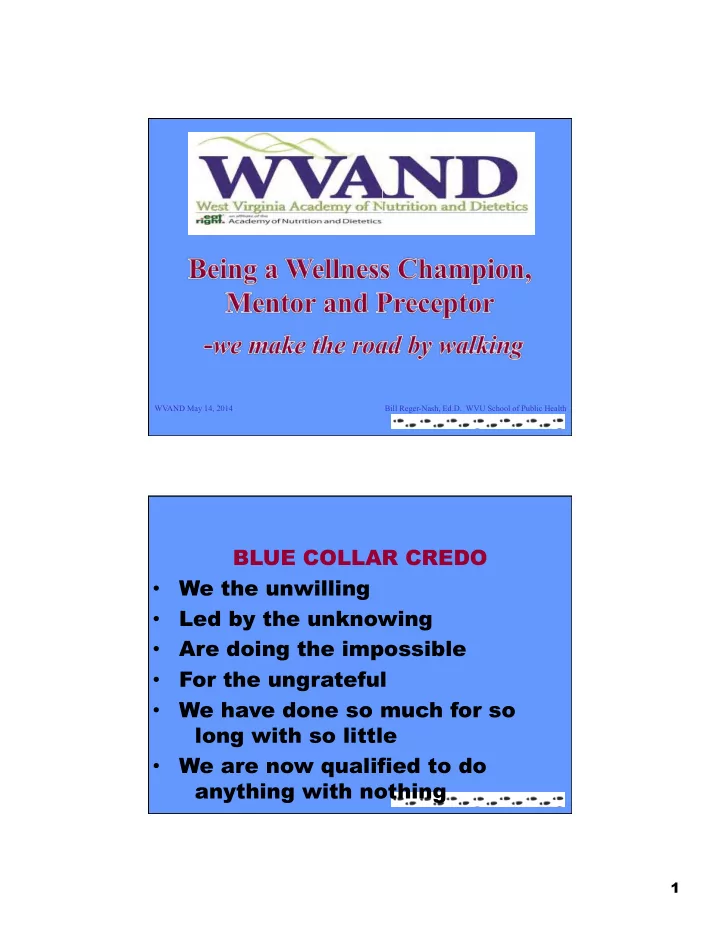

WVAND May 14, 2014 Bill Reger-Nash, Ed.D. WVU School of Public Health BLUE COLLAR CREDO • We the unwilling • Led by the unknowing • Are doing the impossible • For the ungrateful • We have done so much for so long with so little • We are now qualified to do anything with nothing 1
Domains of Wellness Mindfulness Characteristics of Leadership Define Mentoring Participatory Planning Application to Preceptor Roles CLUTTER CLUTTER CLUTTER CLUTTER CLUTTER CLUTTER CLAMOR CLUTTER CLUTTER CLUTTER CLUTTER CLUTTER CLUTTER CLUTTER CLUTTER CLAMOR CLAMOR CLUTTER CLUTTER CLUTTER CLUTTER CLUTTER CLUTTER CLUTTER CLUTTER CLAMOR CLUTTER CLUTTER CLUTTER CLUTTER CLAMOR CLUTTER CLUTTER CLUTTER CLUTTER CLUTTERCLUTTER CLAMOR CLUTTER CLUTTER CLAMOR CLUTTER CLUTTER CLAMOR CLUTTER 2
According to the American Cancer Society (2012), it “…is a mind-body process that uses concentration … to calm the mind, … the intentional self-regulation of attention, a mental focus on a particular aspect of one’s inner or outer experience. 3
MINDFULNESS -the art of paying attention -five minutes for yourself -non-judgmental awareness -zoning in CLUTTER CLUTTER CLUTTER CLUTTER CLUTTER CLUTTER QUIET CLUTTER CLUTTER CLUTTER CLUTTER CLUTTER CLUTTER CLUTTER INNER PEACE PATIENCE CLUTTER CLUTTER CLUTTER CLUTTER CLUTTER CALM CLUTTER CLUTTER CLUTTER NON-JUDGING CLUTTER CLUTTER CLUTTER TRUST CLUTTER NON-STRIVING CLUTTER ACCEPTANCE CLUTTER LET GO 4
Mind wandering appears to be our default mode of living. Killingsworth, Science, 2010 “No matter what people are doing, they are much less happy when their minds are wandering than when their minds are focused.” Killingsworth, 2010, p 88. Start a personal mindfulness practice to develop your innate leadership talents. Michael Carroll, The Mindful Leader, 2007 We cannot “sell” what we do not have. Reger-Nash et al. 2015 5
PMIG March 16, 2011 Bill Reger-Nash, Ed.D. WVU Community Medicine 6
WELLNESS “the integration of body, mind, and spirit— the appreciation that everything you do, and think, feel, and believe has an impact on your state of health and the health of the world.” Travis and Ryan 2004, p. xvi. Seven Attitudinal Foundations: • Non-Judgmental awareness • Patience • Beginner’s Mind • Trust • Non-Striving • Acceptance • Letting Go 7
Workplace Culture “Toxic” workplace is often the norm Tension, anxiety and stress impede performance GOAL Enable and reinforce best in • Self • Others 8
Leadership qualities: • Humility - confidence and respect • Empowering – enable associates to feel capable • Collaborative - solicit input so that everyone feels ownership • Communication - share vision • Fearlessness - not afraid to make mistakes The Mindful Leader (Carroll 2007) • Courage and non-judgmental awareness in the face of workplace difficulties • Acceptance to pursue organizational goals without neglecting what’s happening here and now • Trust yourself and your qualities, the ability to have self-confidence about who you are • Lead with wisdom and patience, not just with ambition and power 9
Mentoring • transmission of knowledge, skills, social support, and trust • relevant to work, career, or professional development • communication during a sustained period Bozeman and Feeney 2007 People do not succeed when: 1. They do not know what to do 2. They do not know how to do it 10
Social- Social -Ecological Model of Influences on Health Behaviors Ecological Model of Influences on Health Behaviors Policy/Systems Policy/Systems Community/Environment Community/Environment Institutional/Organizational Institutional/Organizational Interpersonal Interpersonal Individual Individual WVU Physical Therapy October 20, 2010 Bill Reger-Nash, Ed.D. WVU Community Medicine PARTICIPATORY PLANNING 11
Needs Assessment • Establish steering • Assess Environments, committee (2-4 Policy, Systems, persons) Behaviors • Informational exchange • 6-week Participatory • Ownership Planning program HOW do we transform a traditional do-it-TO-them management culture into an engaged one? Participatory Planning 12
The more ownership, the more likely a program will be effective. Purdey, Adhikari, Robinson and Cox, 1994. This FIRST HAND experience is achieved through participants’ simultaneous involvement in three types of structured experiences over a six week period: INFORMATIONAL EXPERIENTIAL ACTION / TASK FORCES 13
Planning • Task Forces • Pursue trusted • Goals, Objectives resources • Assess resources • Identify staff and consultants Implementation • Ownership • Goals, Objectives • Delegation 14
Evaluation • Iterative process • Goals, Objectives • Continuous Quality • Assess personnel Improvement CONCLUSIONS • We are all teachers and learners. • We walk together to fine-tune insight, attitudes, skills, try out new behaviors, and form habits through the steps of mindfully living well. • We make the road by walking (Horton and Friere 1990) … mindfully. 15
Be curious Trust yourself Have fun WVU Physical Therapy October 20, 2010 Bill Reger-Nash, Ed.D. WVU Community Medicine 16
17
Recommend
More recommend